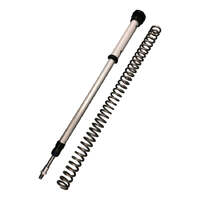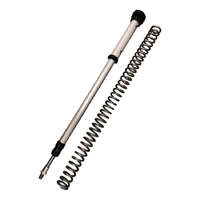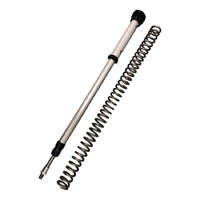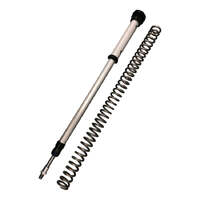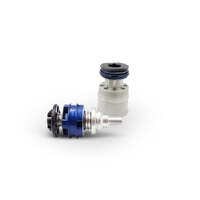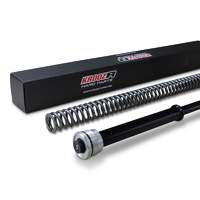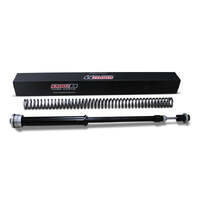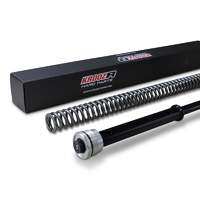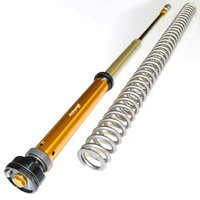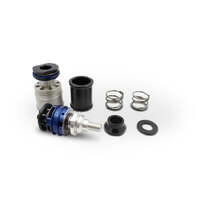Motorcycle Air Fork Coil Spring Conversion Kits
When most riders talk performance the first thing they think of is POWER - but if you're smart, that's the last on the list. Shoving grunt into a chassis that can't cope builds a scary bucking bronco. First steps are basics - make sure your bike is properly maintained, clean, no leaks, fresh oil, good clutch setup. Remove any extra weight. Fit grippy tyres. You've got the perfect starting point! Quality suspension comes next & Teknik Motorsport are motorcycle suspension tuning experts.
Modern air front forks are super light & quickly adjustable using hand pumps, being developed for serious motocross offroad racing bikes - but they aren't perfect. Using pneumatic pressure as the main "spring" means a very progressive rate - initial travel is droopy soft & end is rock hard - even with the help of a balance spring. Sliding friction as well as stiction (initial breakaway) from those air tight seals is very high too - making damping responses even less linear.
Are you sick of the constant pump-up & pressure leaks out of short lived seals? Riding in remote places? Don't want to compensate for heat & altitude? What if weight doesn't matter & you want something predictable & reliable for enduros or long adventures? Fiddly compressed air don't suit some riders. If you want that fancy new engine & chassis, but with predictable spring & damper response, you'll benefit from one of these aftermarket Krooztune inner cartridge conversion kits.

Krooztune Showa 49mm TAC Air Fork to SFF Coil Spring Conversion Kit - with Optional Spring - 2015 CRF250
Proudly made in Australia(SKU: KT-TACSPGKIT-CRF1)
2 In Stock
2 In Stock
Nil Stock
Nil Stock
2 In Stock
Nil Stock
2 In Stock
2 In Stock
2 In Stock
2 In Stock
1 In Stock

Krooztune Showa 49mm TAC Air Fork to SFF Coil Spring Conversion Kit - with Optional Spring - 2016-2017 CRF250
Proudly made in Australia(SKU: KT-TACSPGKIT-CRF2)
4 In Stock
4 In Stock
Nil Stock
Nil Stock
4 In Stock
Nil Stock
4 In Stock
4 In Stock
4 In Stock
4 In Stock
2 In Stock

Krooztune Showa 49mm TAC Air Fork to SFF Coil Spring Conversion Kit - with Optional Spring - 2015-2017 KXF450
Proudly made in Australia(SKU: KT-TACSPGKIT-KXF)
4 In Stock
4 In Stock
Nil Stock
Nil Stock
4 In Stock
Nil Stock
4 In Stock
4 In Stock
4 In Stock
4 In Stock
2 In Stock

Krooztune Showa 49mm TAC Air Fork to SFF Coil Spring Conversion Kit - with Optional Spring - 2015-2017 RMZ450
Proudly made in Australia(SKU: KT-TACSPGKIT-RMZ)
6 In Stock
6 In Stock
Nil Stock
Nil Stock
6 In Stock
Nil Stock
6 In Stock
6 In Stock
6 In Stock
6 In Stock
3 In Stock

Krooztune WP 35mm AER Air Fork to Coil Spring Conversion Kit - KTM / GasGas / Husqvarna 50cc
Proudly made in Australia(SKU: KT-WPATS-AER35)
3 In Stock
Nil Stock
Nil Stock
3 In Stock

Krooztune WP AER48 Air to Spring Conversion Husqvarna TC/FC 2021-2023
Proudly made in Australia(SKU: KT-WPATS-AER48-HSQ)
6 In Stock
6 In Stock
Nil Stock
Nil Stock
6 In Stock
Nil Stock
6 In Stock
6 In Stock
6 In Stock
6 In Stock
3 In Stock

Krooztune WP 43mm AER Air Fork to Coil Spring Conversion Kit - KTM / GasGas / Husqvarna 85cc
Proudly made in Australia(SKU: KT-WPATS43)
Nil Stock
19 In Stock
19 In Stock
16 In Stock
19 In Stock
16 In Stock
19 In Stock
9 In Stock

Krooztune WP 48mm AER Air Fork to SFF Coil Spring Conversion Kit - with Optional Spring - KTM / Husqvarna (All) 2016-2020 and Long TX/FX 2021-on
Proudly made in Australia(SKU: KT-WPATS48)
8 In Stock
6 In Stock
Nil Stock
Nil Stock
25 In Stock
Nil Stock
26 In Stock
19 In Stock
20 In Stock
25 In Stock
12 In Stock
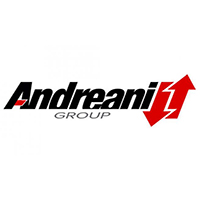
Complete Cartridge kit SFF KTM/Husqvarna TC FC SX SX-F 2021 on
Conversion kit (air to spring) fork WP AER 48(SKU: 106KT5)

Krooztune WP35 Fork Flow Kit - KTM Group 50cc (Including Air To Spring Conversion)
Proudly made in Australia(SKU: KT-WPAER35FFK-50)
Nil Stock
Nil Stock
Nil Stock
Nil Stock
When most riders talk performance the first thing they think of is POWER - but if you're smart, that's the last on the list. Shoving grunt into a chassis that can't cope builds a scary bucking bronco. First steps are basics - make sure your bike is properly maintained, clean, no leaks, fresh oil, good clutch setup. Remove any extra weight. Fit grippy tyres. You've got the perfect starting point! Quality suspension comes next & Teknik Motorsport are motorcycle suspension tuning experts.
Modern air front forks are super light & quickly adjustable using hand pumps, being developed for serious motocross offroad racing bikes - but they aren't perfect. Using pneumatic pressure as the main "spring" means a very progressive rate - initial travel is droopy soft & end is rock hard - even with the help of a balance spring. Sliding friction as well as stiction (initial breakaway) from those air tight seals is very high too - making damping responses even less linear.
Are you sick of the constant pump-up & pressure leaks out of short lived seals? Riding in remote places? Don't want to compensate for heat & altitude? What if weight doesn't matter & you want something predictable & reliable for enduros or long adventures? Fiddly compressed air don't suit some riders. If you want that fancy new engine & chassis, but with predictable spring & damper response, you'll benefit from one of these aftermarket Krooztune inner cartridge conversion kits.
These conversions keep compression & rebound adjustment in separate legs like the stock setup - but are filled with suspension fluid & use a traditional wire spring - the reliable oil & coil setup completely replacing leaky original factory gas damping internals. Installation doesn't need a mechanic, skilled DIY garage tuners should find this easy. Customised comp & reb pressures are clicks away, so is preload adjustment for the new steel springs.
Watching racing videos, do the winners look like they're being kicked around? That circuit star can lean further, without braking dive, sailing over cornering bumps that push you off line. That motocross hero hooks up on loosest dirt, turns quicker after landing jumps, floats over whoops that rattle you roughly. Are they more skilled? Maybe. But their motorbike is predictable & controlled, giving confidence to push grip further & time to concentrate on faster laps.
Tuned suspensions aren't just for the track though. Riding on potholed tarmac or offroad trail adventures improves too - a smooth ride, comfortable saddle no longer absorbing corrugations & vibration, longer endurance. Keeping safe tyre contact with the road under all conditions gives more grip & acceleration.
So now you've built up some skills & experienced riding a competent bike, how about setting up your gearing for better lap times & ridability? You're finally ready to turn up the wick with a screaming tuned engine & a blasting aftermarket muffler - but have a think about it first.



